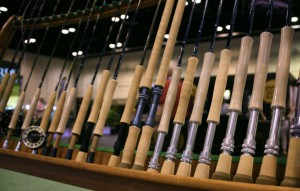By Louis Cahill
Are you curious about what the terms switch and spey mean in fly-fishing? Here are some answers.
I recently shared an older article about choosing a line for your switch rod as a Sunday Classic. The comments section lit up pretty quickly about the terms switch and spey. I thought it might be a good time to try and give a little perspective on the terms, what they mean and where they come from. Whether you are a single-hand or two-hand caster, you’ll find this interesting.
What is a spey rod?
Spey rods were developed in Scotland for fishing Atlantic salmon. They are long rods, 12 feet six inches or longer, with upper and lower grips, intended for casting with two hands. These rods were born of necessity. Salmon anglers needed to make long casts with little or no room for backcasting. They also needed to manage long lines as they swung their flies.
The answer was a long limber rod, which could be loaded and cast without a backcast. Of course, to do this, a style of casting had to be developed to accommodate both the rods and the rivers. This style of casting became known as spey casting, for the Spey River where it was born. These long rods were heavy and awkward to manage, so it was necessary for anglers to use two hands to cast them. It is important to note that spey casting and spey rods are two ideas, separate but associated. You can make any spey casts with a single-hand rod. You can also make overhead casts with a spey rod, although there are some good reasons not to make a habit of it.
To further complicate the matter, anglers in the US and Canada started using a radically different line configuration on their spey rods. Called skagit heads, for the river where they were developed, these aggressive shooting heads and their heavy, interchangeable sinking tips revolutionized steelhead fishing. Along with those lines came a new style of casting created to lift those heavy systems. Although some folks call these skagit casts, they are more often lumped into the family of spey casts. It’s also worth noting that you can, and some anglers do, fish these shooting heads on single-hand rods, even if it means significant physical pain at the end of the day.
What is a switch rod?
Switch rods were born around the 1970s and took a while to catch on. A switch rod is quite simply a two-hand rod, which is shorter than 12 feet six inches. The idea was, and is, that an angler could cast these rods with one hand or two, depending on the situation and their objectives.
It worked. Switch rods have become very popular for their incredible versatility. They offer the angler the ability to perform two-hand spey casts, single hand spey or overhead casts, manage line wonderfully and, in lighter weights, can even be used for euro-nymphing. The switch rod is a true “jack of all trades” and, as the saying goes, “master of none”.
There is an inherent compromise at work in switch rods. In order to make them perform a wide variety of angling tasks, designers have developed tapers which do a lot of different things, fairly well, but none perfectly. Nevertheless, switch rods have become very popular with a variety of anglers. While you are likely to see anglers here in the East fishing them with one hand and often nymphing, you will also see anglers in Colorado swinging flies for trout, in much the same way anglers in the Northwest target steelhead. Steelhead anglers have embraced them for spey casting on small rivers with dense vegetation.
Micro Spey
Some steelhead anglers, who wouldn’t be caught dead making an overhead cast, got tired of the compromise. In recent years several companies, like Winston for example, started making rods they called micro-spey rods. These rods are essentially switch rods, without the switch.
With these rods, rod designers returned to more traditional actions, which favor two-hand spey casting. Can you still cast these rods with one hand? Of course you can, but hey are very soft and may not be the best choice for the single-hand angler. Are they a completely different animal? No, they certainly are not, just another option in a wide array of fly rods on today’s robust market.
Action, grips and special purpose rods
Rods made for spey casting generally have slower action. There are, of course, slower and faster spey rods, but in general they are slower than single-hand rods. This makes them easier to load using casts which don’t involve backcasting. The action of any rod is greatly affected by the weight of the line it casts. This is never more true than with spey rods. That’s why the line systems used are sold by grain weights rather than rod weights. It’s left to the angler to decide which weight line performs best for their casting style.
Single-hand rods, for the most part, have much faster actions. Throwing the weight of the line behind you allows you to load a pretty stiff rod, especially if you have good technique. These rods make tight loops, perform well in the wind and put anglers on fish in almost every situation. Single-hand casting is more easily mastered and so these rods make up the vast majority of the market. Switch rods, as I’ve said, attempt to marry the two actions.
The grips on these different styles of rods are very different as well. Obviously a two hand rod has two grips to accommodate both hands. Many single-hand rods have fighting butts, designed to brace against the angler’s body when fighting big fish. Some folks think this is the same as the second grip on a switch or spey rod. You can certainly grab the fighting butt and let rip with a two-hand cast, and I know one very effective angler who does, but that’s not really where the difference lies.
The front grip on a two-hand rod is much longer than a single-hand grip. This allows you to separate your hands on the rod by as much as a couple of feet. This gives you powerful leverage to manage that long rod and better body mechanics for casting. I suppose you could grab your single-hander a foot up the blank, but you’d be defeating the action of the rod.
A completely different group of rods are long, single-hand nymphing rods. The action of these rods is fairly unique and purpose driven. They are usually pretty stiff, up to the tip, where they become very soft rather quickly. These rods are made for flicking flies upstream and usually do not perform any other cast well. They are switch rod length, but that’s the end of the similarity.
Companies like Echo are now making two-hand rods meant specifically for overhead casting. These powerful rods combine a fast action with length and a two-hand grip. They are very popular with anglers fishing the surf because they will cast long distances with little effort.
I hope this answers some questions. There’s plenty more to learn about all of these different rods and the lines they cast. If you’re interested in switch and spey rods, I’d recommend reading my three part series on choosing a line for your switch rod. Two-hand rods are a blast to fish and very versatile. I use them for trout and steelhead and I know anglers who use them for species as different as tarpon and carp. If you are like me, and love learning new ways to fly fish, check out some two-hand rods and see what’s right for you.
Louis Cahill Gink & Gasoline www.ginkandgasoline.com hookups@ginkandgasoline.com Sign Up For Our Weekly Newsletter!


I would humbly suggest that length is now no longer any real guide to whether a rod is a Spey rod, my favorite weapon is a Burkheimer 11,7″ 7 weight – very much a Spey rod in action, feel and manufacturer discription.
As for that little company Sage, they have a whole quiver of 12′ Spey rods from 6-9 weight all at the 12′ length. Just a thought as he times change.
I agree completely. The difference between a spey, switch, and traditional single-hand rod isn’t in the length. It’s in the action and line.
More and more people feel that way. I get that. I have a lot of switch rods and most of them have never been cast with one hand. But, I’m hesitant to embrace that idea for 2 reasons. First, it is born of marketing. Let’s face it, this idea came about to differentiate products and attract sales. I’m personally very slow to trust marketing. Secondly, if we start categorizing rods by action, where does it end? How many different actions are there in single hand rods? A good saltwater rod and a sweet fiberglass rod are less alike than a switch and a micro-spey but we call them both fly rods.
Of course, everything in fly fishing has to be an argument. My least favorite thing about the sport, but it’s true. Regardless of our feelings, there is an agreed technical definition and it is length, so I’m sticking to that. It’s not helpful to folks who are getting into 2 hand casting to muddy the water with non-specific terms based on how we feel about our rods.
Only just caught up with the different terms and found out what a Switch Rod is. I’ve bought a 5 WT – 11FT Switch Rod. I guess I now need a reel and it seems to call for an 7/8 WT. But what about the line? I’m used to fishing brown trout, typically 2 to 5 lbs on a 5 WT standard fly rod on which I use a 6 WT FF line. Q. What WT line should I buy for my 5 WT Switch Rod?